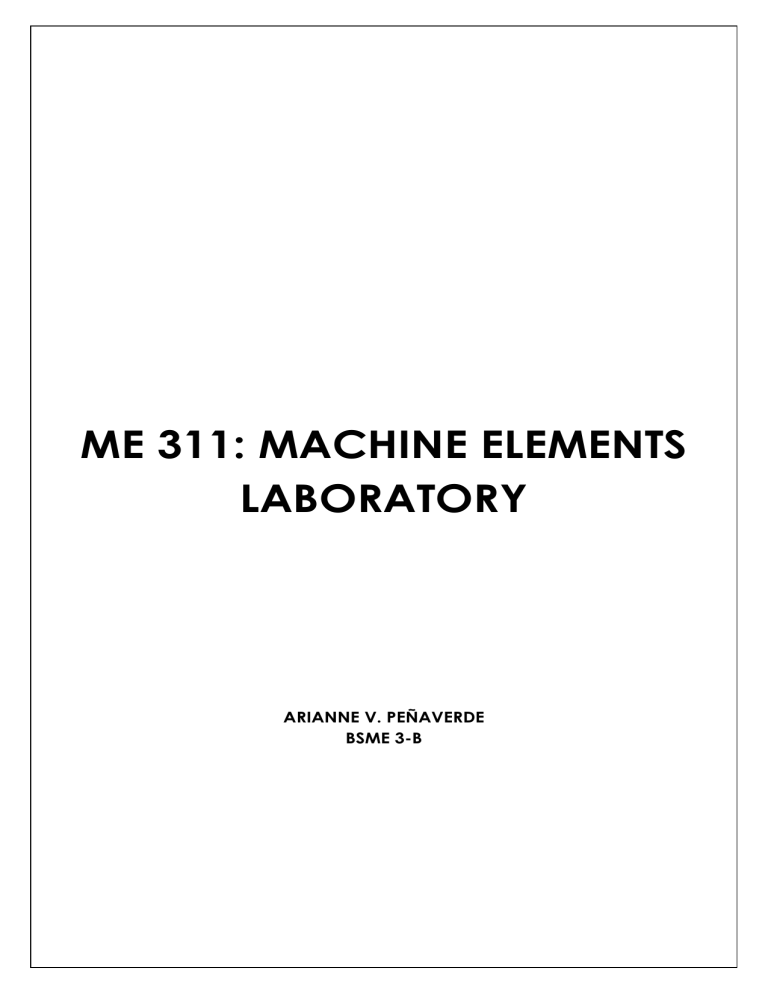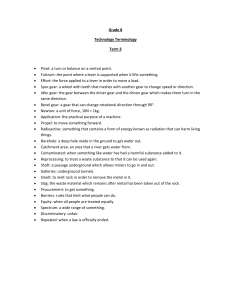
ME 311: MACHINE ELEMENTS LABORATORY ARIANNE V. PEÑAVERDE BSME 3-B LABORATORY EXERCISE #1 Introduction to Mechanisms and Kinematics Figure C1.2 shows a mechanism that is typical in the tank of a water closet. Note that flapper C is hollow and filled with trapped air. Carefully examine the configuration of the components in the mechanism. Then answer the following leading questions to gain insight into the operation of the mechanism. 1. As handle A is rotated counterclockwise, what is the motion of flapper C? The flapper C will rotate clockwise. 2. When flapper C is raised, what effect is seen? The water will be released through the opening. 3. When flapper C is lifted, it tends to remain in an upward position for a period of time. What causes this tendency to keep the flapper lifted? The flapper C remains lifted due to a force called buoyancy, an upward force exerted by the water on the flapper. 4. When will this tendency (to keep flapper C lifted) cease? The flapper will lower if the water level decreases. 5. What effect will cause item D to move? Item D will move downward if the water level decreases. 6. As item D is moved in a counterclockwise direction, what happens to item F? Items D and F rotate in the same direction; therefore, F will also rotate counterclockwise. 7. What does item F control? It controls the water flow of the system. It fills the tank when it is in an upward position and cuts off the flow when it is in a downward position. 8. What is the overall operation of these mechanisms? The mechanism performs the following functions: rapid water flow, refilling of the tank, and cutting off the water flow. 9. Why is there a need for this mechanism and a need to store water in this tank? This mechanism simplifies the use of the restroom, especially the toilet, and there is a need to store water for the disposal of human urine and waste. LABORATORY EXERCISE #2 Vectors Figure C3.2 shows that gear drives a mating gear (not shown) that operates the wire-forming machine. Driveshaft carries collar, which is keyed to it. Gear has a slip fit onto shaft. Two pins, and, attach links and, respectively, to gear. An additional pin on gear is used to hold the end of spring. Carefully examine the configuration of the components in the mechanism. Then, answer the following leading questions to gain insight into the operation of the mechanism. 1. As driveshaft A turns clockwise, what is the motion of collar B? Because of their keyed connection, as driveshaft A spins, collar B likewise rotates. 2. If gear C is not fixed to collar, how can the clockwise motion from the shaft rotate the gear? Because of the interaction of link D's protrusion with the notch in collar B, the rotating motion of the shaft and collar is transferred to gear C. 3. What happens to the motion of gear C if link D is forced upward? Gear C will stop rotating if Link D is face upward, since the protrusion would come out of the notch in Collar B. Therefore, nothing would be left driving gear C. 4. What action would cause link D to move upward? If Gear C would be exposed to significant resistance of rotation (usually cause by extra load on shaft), Link D will move upward. 5. What resistance would link D have to move upward? The Link D will move upward if it overcome the tension of link H which the spring. 6. What is the purpose of this device? The device is designed to stop the rotation of the gear if it encounters significant resistance. 7. What would you call such a device? It is called slip clutch 8. How does this device aid the automatic wire-forming machine described here? If the wire became jammed, this design would halt the winding operation, causing resistance on gear C. 9. This device must be occasionally “reset.” Why and how will that be accomplished? To reset the system, put link D beneath link F and align it with the notch in collar B. 10. Because force is a vector, its direction is important. In what direction must the forces applied by the spring act? The tension of the spring is important in this process because it pulls on link F to the right and link E to the left. 11. List other machines, other than the wire-forming one, that could use this device. Conveyers, Label Printers, & LABORATORY EXERCISE #3: Position and Displacement Analysis Figure C4.1 shows a mechanism that was designed to impart motion on a machine slide. Carefully examine the configuration of the components in the mechanism, then answer the following leading questions to gain insight into the operation. 1. As wheel is rotated clockwise, and slide J remains stationary, what is the continual motion of pin? Pin D will rotate clockwise along the wheel circumference as positioned when the wheel C is rotated clockwise. 2. What is the continual motion of pin P? The motion of pin P is also circular or oscillating along an arc, centered about the joint on the tapped sliding link. 3. What is the continual motion of pin K? The motion of pin K is oscillating translation. 4. What effect does turning the handwheel have on slide? The slide J will move up and down causing all links to move and drive the complete mechanism. 5. What effect does turning the handwheel have on the motion of the mechanism? Be sure to comment on all characteristics of the motion. The rotation of the handwheel determines the motion of slide J, controlling its upward and downward movement, ultimately influencing the press stroke and the rotational direction of all the linked components, whether clockwise or counterclockwise. 6. What is the purpose of this device? The equipment possesses the attributes of a horizontal manual press, suitable for various pressing tasks like cutting, stamping, and embossing, among others. 7. Draw a kinematic diagram and calculate the mobility of the mechanism. Determine the vertical distance that the box truck in Figure P4.26 lowers if the bottom pins are separated from 2.0 m to 1.5 m. LABORATORY EXERCISE #4 Vectors Analysis Figure C6.1 illustrates a mechanism that is used to drive a power hacksaw. The mechanism is powered with an electric motor shaft, keyed to gear A. Carefully examine the configuration in question, then answer the following leading questions to gain insight into the operation of the mechanism. 1. When gear A is forced to rotate counterclockwise, what is the motion of mating gear B? When gear A is forced to rotate counterclockwise, the mating gear B rotates in the opposite direction, which is clockwise. 2. When gear A is forced to rotate counterclockwise, what is the motion of stud pin C? The stud pin C moves in the direction of the mating gear B, which rotates clockwise as gear A rotates counterclockwise. 3. When gear A is forced to rotate counterclockwise, what is the motion of lever D? Since Lever D pivots at its right end, it undergoes rotational oscillation when gear A is rotated counterclockwise. 4. How does the motion of lever D differ from the motion of lever E? In the mechanism, link D and link E are arranged in a rocker-rocker configuration, and link D impels link E. As link E is shorter, it results in a larger angular displacement than link D. 5. Determine the position of gear B that would place lever D at its lower extreme position. When the center of the slot is tangent to the bottom of the path of pin C, link D will be at its lowest extreme position. 6. Determine the position of gear B that would place lever D at its upper extreme position. When the center of the slot is tangent to the top of the path of pin C, link D will be at its upper extreme position. 7. Examine the amount of rotation of gear B to raise lever D and the amount of rotation to lower the lever. Gear B must revolve roughly 210 degrees to raise lever D and approximately 150 degrees to lower it 8. Approximately what is the difference between the time to raise and the time to lower lever D? According to no. 7, raising the lever demands more extensive rotation of gear B than lowering it, resulting in a longer time required to raise lever D compared to lowering it.. 9. Comment on the continual motion of lever E. The motion of link E is quick-return For the rear windshield wiper mechanism shown in Figure P6.25, use the relative velocity method to analytically determine the angular velocity of the wiper arm as the crank rotates counterclockwise at 45 rpm.




